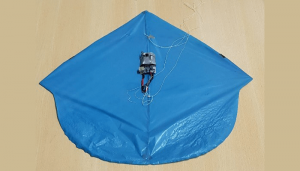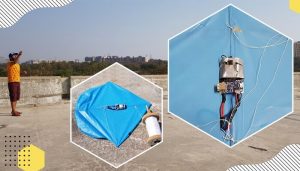In a move that puts a novel spin on aerial photography, IIITH researchers unveil a unique kite camera that promises to be a cost-effective alternative to drones and the existing Kite Assisted Photography (KAP).
Time was when aerial photography was limited to photographs taken from aircrafts. With the advent of the ubiquitous drones, photography and aerial surveillance got a shot in the arm because the drones could go where people could not. This meant that remote and inaccessible areas could be monitored cheaply and accurately, more so in the aftermath of natural disasters. However, while drones have a plethora of benefits including in the area of logistics and delivery, using them for recreational photography or for extended periods of time is an expensive proposition.
What started as an experimental quest for a low-cost everyday solution to aerial photography led IIITH Researchers from the Process, Architecture, and Technology Research in IoT (PATRIoT) lab to design a complete lightweight system that can be affixed to any ordinary kite for capturing images. Unlike the present-day KAP structures that necessitate tethering a camera to a sturdy, specially tailored kite via a rig, the system labelled KiteCam is very simplistically just that : a kite with a sleek camera module attached to its spine.

Studying Wind
Since a kite depends on wind for flying, the research team led by student Abhinav Navnit under the guidance of Dr. Aftab Hussain, first conducted super avana an in-depth study of flight dynamics. “The normal Indian patang (kite) that you get has a weight of 10-15 gms, so in order to lift it and anything else mounted on that, one requires appropriate wind force. We figured out that normal wind conditions can carry something like 50gms, of which 10gms is the weight of the kite itself. So our entire system had to fit into approximately 40gms,” explains Dr. Hussain. The system which uses a camera, a processor and a battery found its single biggest challenge in typical batteries being bulky and heavy. To counteract this, the team used two ultra-light and flexible lithium polymer batteries that weigh only 4.65 gms each. At 42 gms, the complete setup consisting of the batteries coupled with the camera and power management modules successfully weighed below the maximum limit required for lift-off.

Superiority Over Drones
In the first test flight itself, the KiteCam revealed its superiority over drones in terms of energy consumption by successfully flying for 35 minutes, during which a total of 4,356 images were taken. Terming this an unobtrusive way of surveillance, Dr. Hussain highlights the whirring noise and the size of drones that make them unlikely candidates for fact-finding missions in sensitive areas. Another plus that works in favour of the KiteCam is that since most of the KiteCam’s surface area is non-electronic, it cannot be detected by radars. According to the professor though, the greatest advantage of the KiteCam is that it is battery-free. “Unlike a drone, the lift of the kite here is getting created through wind power and not battery power. It makes a huge difference between battery capacity and battery utilisation,” says Dr. Hussain. Based on the wind speed and camera settings, it was found that the current KiteCam design can perform surveillance for as long as six hours in a single flight.

Paper Presentation
Speaking of the project and the manner in which the idea germinated, Abhinav says, “The idea of KiteCam was spontaneously conceived by (Aftab) Sir when our whole research group was out on a small party on the occasion of Makar Sankranti (good ol’ pre-Covid times). We were looking at the Kite-based decor in the restaurant when Sir thought aloud about using such a low cost and commonly available aerial platform for surveillance instead of drones. A month later, the actual model took its first flight!” Based on the outcome, a paper titled “KiteCam – a novel approach to low-cost aerial surveillance” was published and presented at the IEEE Sensors Conference in November 2020.

Finetuning Capabilities
For surveillance, while one could argue in favour of sophisticated satellites and drones, the key differentiator is the low cost of the kite. “Helium balloons too have some of the advantages of a kite such as low power, but their transient nature – they diffuse quickly – and comparative higher costs are stumbling blocks,” says Dr. Hussain, whose group has been actively conducting several other aerodynamic experiments too. He does admit that there are downsides of using a kite. “For one, you should have good kite flying skills. And unless you’re looking to quickly scan a wide area, it’s harder to precision control a kite for surveying a specifically marked out small area.”

To advance the current capabilities of the KiteCam, plans are afoot to include optimizing the shutter speed for better image stability and reducing the frames captured per second in order to save battery capacity. Other usages have been chalked up too such as mounting sensors for temperature, humidity, pollution and so on for aerial environmental monitoring.



Next post